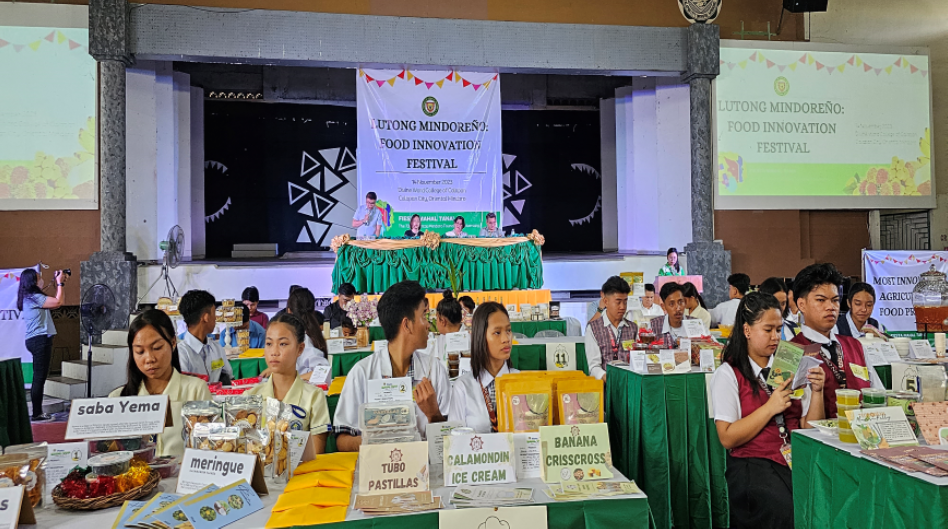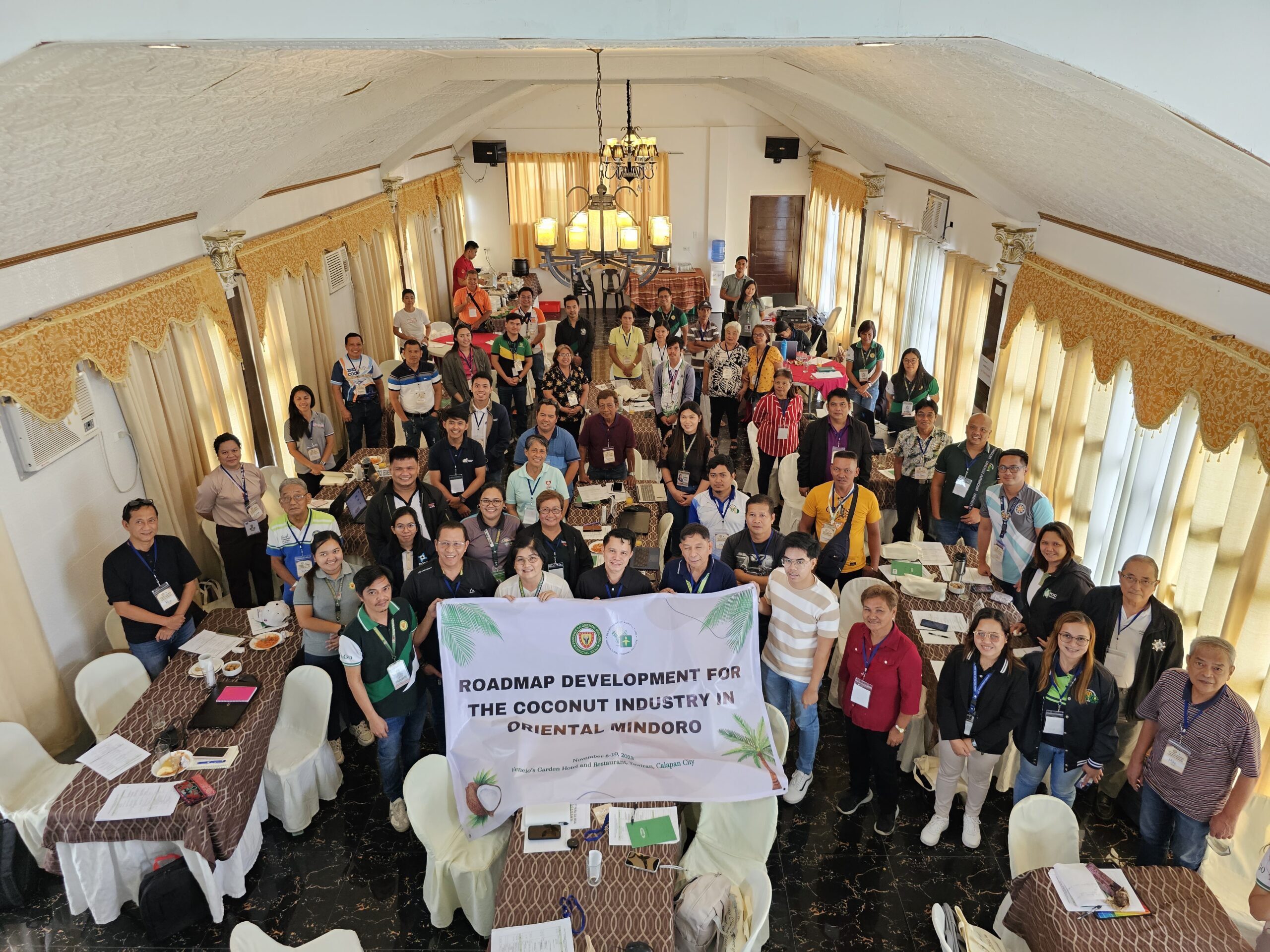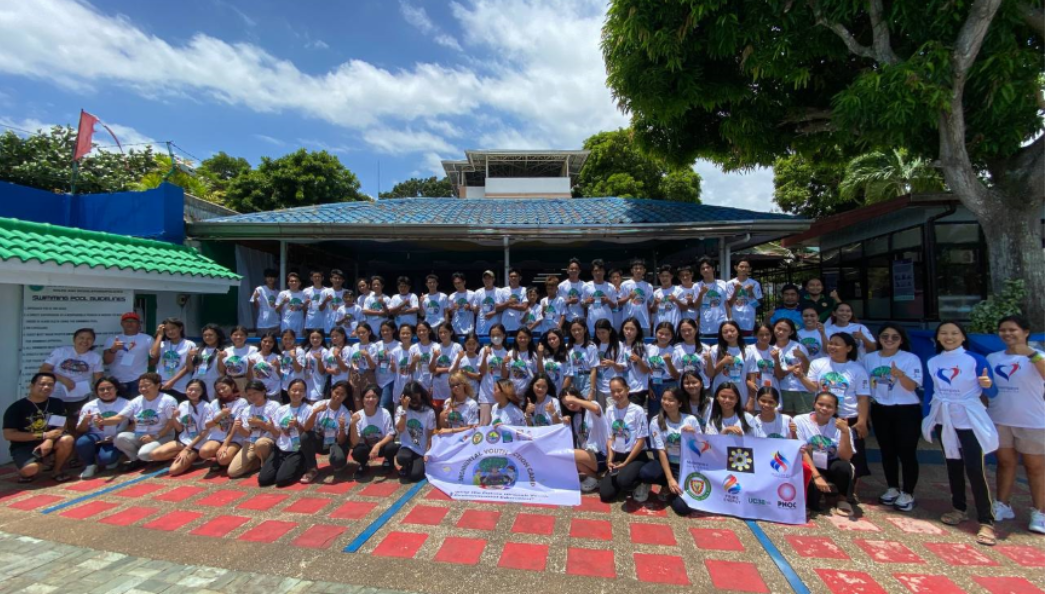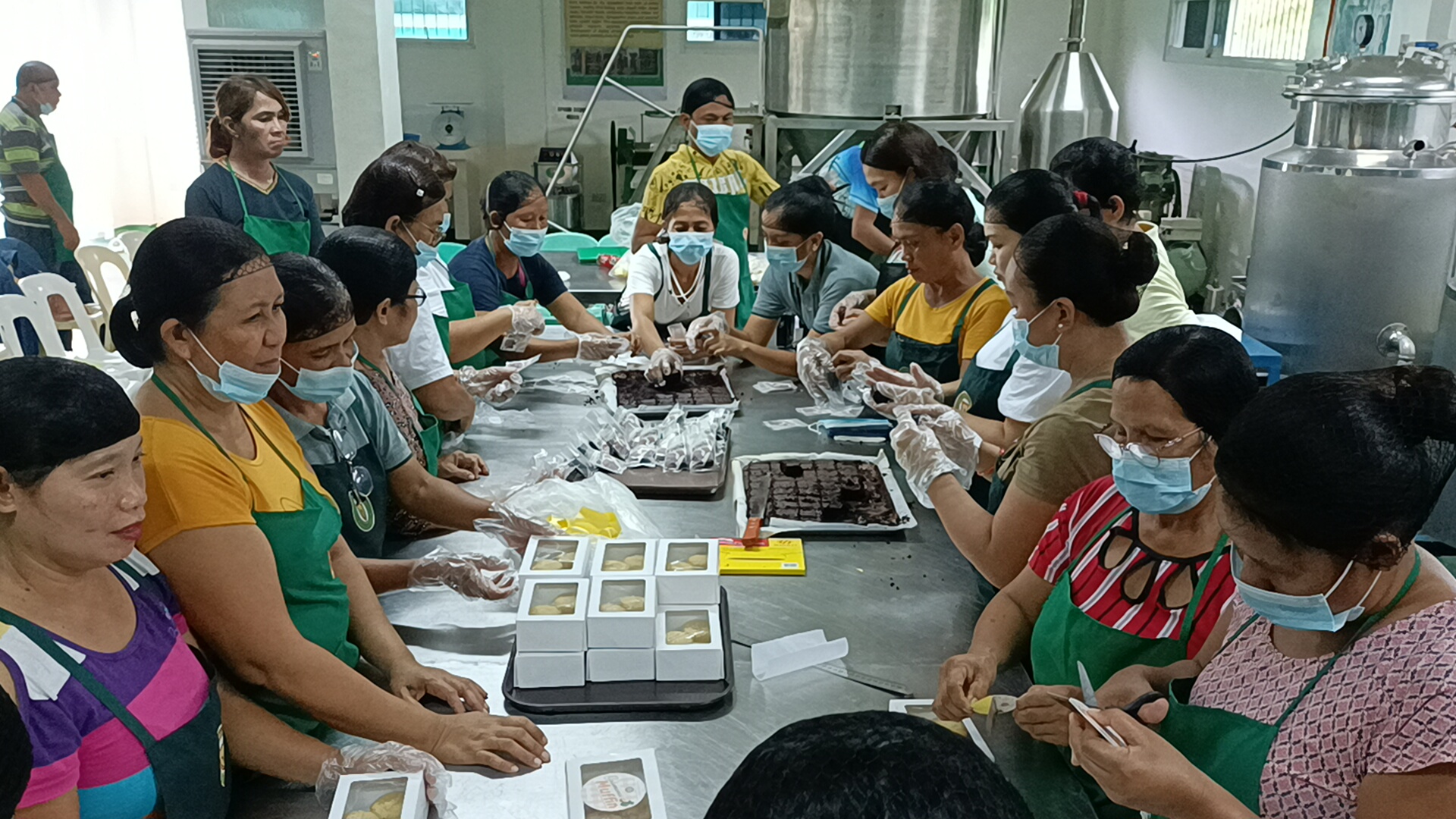AGRI-PROFILE: POLA, ORIENTAL MINDORO
Pola, Oriental Mindoro
About 65 percent or 10,501.426 hectares of Pola’s total land area are devoted to agriculture. Coconut is the major agricultural crop occupying 4,500 hectares distributed in all barangays. Banana is the second predominant crop planted in all barangays. There are 1,065 hectares of irrigated rice planted by 582 farmers in 13 barangays and 350 hectares of non-irrigated rainfed) rice planted by 280 farmers in other barangays. The municipality is also a major producer of high value crops, citrus, fruit trees and vegetables. Table below shows the area coverage and average production of major agricultural crops.
Existing Major Agricultural Crops by Area, Production and Market
Existing Major Agricultural Crops by Area, Production and Market, 2009
| Major Crops | Area | Production | Product Market | |||
| Hectares | % Total | Volume (MT) | Value (Php) | Local | Export/other areas | |
| 1. Rice | ||||||
| Irrigated | 1,065.00 | 10.14 | 5,325 | 74,5550,000.00 | Batangas- Manila | |
| Non-irrigated | 350.00 | 3.33 | 1,400 | 19,600,000.00 | Batangas- Manila | |
| 2. Banana | 2,520.00 | 24 | 25,200 | 25,200,000.00 | Batangas- Manila | |
| 3. Coconut | 4,500.00 | 42.85 | 9,000 | 135,000,000.00 | Lucena City & Manila | |
| 4. Citrus/Oranges | 1,408.00 | 13.41 | 5,632 | 50,688,000.00 | Batangas- Manila | |
| 5. Other HVC, Rambutan, Lansonez, Mango and Coffee | 658.426 | 6.26 | 1,456 | 21,787,500.00 | Manila | |
| TOTAL | 10,501.426 | 100 | 48,022 | 326,825,500.00 | ||
| Source: Municipal Agriculturist's Office | ||||||
Farming Techniques
The current farming practices consist of several components. Farming management practices varies for individual crops. Cropping systems consist of interrelated activities in the farm which involve the quality of land, crops planted, livestock raised, climate or weather condition and availability of water supply.
The types of cropping system are the following:
1. Mono-cropping – growing of single type of crop on a piece of land on an annual basis like palay, coconut and citrus.
2. Intercropping – growing of two types of crops simultaneously on the same piece of land. Farmers have a base crop like coconut intercrop with banana or any other crops planted in between rows of the main crop. The main objective of intercropping is to maximize the use of land for higher production and stability of farmer’s income.
3. Mixed cropping system – a common practice of farmers in one backyard. It is the growing of two or more crops intermingled without any row pattern. The objective is to meet per capita requirements for vegetables and other crops. The system is also popularly known as subsistence farming.
4. Integrated farming – it is a method of integrating major permanent crops like fruit trees/HVCC with vegetables/roots crops, poultry and livestock and inland fishery for sustainability. It is the intensification of cropping in time and space dimension. Through integrated farming, forage grasses were planted to serve as feeds for small and large ruminants. Farmers allow livestock to graze the land reducing labor cost on grass cutting, in turn the excreta of these animals serve as fertilizer for some crops. When livestock and crops attain a certain level of growth, they were marketed providing additional income for farmers. This practice is considered as sustainable agriculture aimed at meeting the needs of the present generation without endangering and damaging the resource base of the future generation. It is also known as organic or natural farming considered as low input but highly productive system. Organic matter like animals’ and plants wastes serve as the main source of fertilizer. Table 5.2 below shows the different farming techniques in different barangays.
Farming Techniques in Different Barangays
| Barangay | Farming Techniques | |||
| Mono cropping | Intercropping | Mixed cropping | Integrated farming | |
| Bacawan | 29 | 806 | 21 | 0 |
| Bacungan | 121 | 91 | 0 | |
| Batuhan | 13 | 65 | 5 | 0 |
| Bayanan | 18 | 53 | 10 | 0 |
| Biga | 146 | 114 | 12 | 0 |
| Buhay na Tubig | 20 | 649 | 6 | 0 |
| Calima | 15 | 714 | 20 | 0 |
| Calubasanhon | 25 | 750 | 30 | 0 |
| Campamento | 21 | 496 | 12 | 0 |
| Casilingan | 161 | 199 | 5 | 0 |
| Malibago | 155 | 518 | 8 | 0 |
| Maluanluan | 438 | 425 | 21 | 2 |
| Misong | 18 | 215 | 9 | 0 |
| Pahilahan | 35 | 773 | 12 | 0 |
| Panikihan | 23 | 314 | 20 | 0 |
| Pula | 220 | 689 | 40 | 0 |
| Puting Cacao | 25 | 496 | 10 | 0 |
| Tagbakin | 50 | 585 | 16 | 0 |
| Tagumpay | 35 | 299 | 9 | 0 |
| Tiguihan | 10 | 266 | 6 | 0 |
| TOTAL | 1660 | 9406 | 307 | 2 |
| Source: Municipal Agriculturist's Office | ||||
Grains Production
• Rice About 75 percent of the total rice area of Pola is irrigated while 25 percent are non-irrigated. Table 5.1 shows that Pola produced 6,725 metric tons of Palay. Rice production performance in the municipality is satisfactory with an average productivity of 4.75 metric tons per hectare per annum. There are five major rice producing barangays- Maluanluan, Casiligan, Biga, Pula and Panikihan representing 70 percent of the total irrigated areas.
Most of the farmers in Pola practice semi-mechanized farming in the land preparation of rice field using carabao drawn plough and hand tractors. Trans planting of rice seedlings and harvesting are done manually. Post-harvest facilities are limited and palay drying in basketball courts, roads and vacant lots are common during harvest season.
• Permanent and High Value Crops (HVC)
Approximately 9,086.43 hectares were devoted to permanent and High Value Crops (HVC). Of these, coconut occupied the biggest area equivalent to42.85percent followed by banana (24%), citrus (13.41%) and other high value crops – oranges, rambutan, lanzones, durian, mango and coffee 6.26%.
For the year 2015, banana production is 25,200 metric tons, followed by coconut at 9,000 metric tons, citrus at 5,632 metric tons and other high value crops (HVC) at 1,465.
The common methods of coconut harvesting and drying are still being practiced by the farmers in upland and lowland areas. Coconut is being harvested in practical ways through climbing and using bamboo pole with bladed gadgets. Copra drying is done either by flatbed smoking and sun drying.
Harvesting of banana, citrus and high value crops are done manually with the aid of improvised bamboo ladders.
Existing Agricultural Support Facilities and Services
| Post-harvest facilities and support services | Location | Number | Type/Capacity | % Utilization | Remarks Operational, Need Repair etc. |
| Milling | Batuhan | 1 | Kiskisan | 100% | Operational |
| Maluanluan | 2 | Kiskisan | 100% | Operational | |
| Casiligan | 1 | Kiskisan | 100% | Operational | |
| Malibago | 1 | Kiskisan | 100% | Operational | |
| Biga | 1 | Kiskisan | 100% | Operational | |
| Multi-Purpose Drying Pavement(MPDP) | Malibago | 2 | Solar/30 sacks | 100% | Operational |
| Tagbakin | 1 | Solar/50 sacks | 100% | Operational | |
| Biga | 4 | Solar/30 sacks | 100% | Operational | |
| Pula | 4 | Solar/30 sacks | 100% | Operational | |
| Bacungan | 3 | Solar/40 sacks | 100% | Operational | |
| Casiligan | 2 | Solar/20 sacks | 100% | Operational | |
| Malualuan | 11 | Solar/35 sacks | 100% | Operational | |
| Market Centers | Poblacion | 1 | 100% | Operational | |
| Warehouse | Maluanluan | 2 | 100 bags | Operational | |
| Calima | 2 | 50 sacks | Operational | ||
| Bacawan | 1 | 50 sacks | Operational | ||
| Flat Bed Dryer | Casiligan | 1 | 100 bags | Operational | |
| Pula | 1 | 100 bags | Operational | ||
| Biga | 1 | 100 bags | Operational | ||
| Hand Tractor | Bacungan | 9 | 2ha./day | 100% | Operational |
| Batuhan | 2 | 2ha./day | 100% | Operational | |
| Biga | 10 | 2ha./day | 100% | Operational | |
| Campamento | 3 | 2ha./day | 100% | Operational | |
| Casiligan | 12 | 2ha./day | 100% | Operational | |
| Malibago | 14 | 2ha./day | 100% | Operational | |
| Maluanluan | 25 | 2ha./day | 100% | Operational | |
| Matulatula | 3 | 2ha./day | 100% | Operational | |
| Panikihan | 3 | 2ha./day | 100% | Operational | |
| Pula | 12 | 2ha./day | 100% | Operational | |
| Tagbakin | 3 | 2ha./day | 100% | Operational | |
| Thresher | Bacungan | 3ha.day | 100% | Operational | |
| Batuhan | 3ha./day | 100% | Operational | ||
| Biga | 3ha./day | 100% | Operational | ||
| Campamento | 3ha./day | 100% | Operational | ||
| Casiligan | 3ha./day | 100% | Operational | ||
| Malibago | 3ha.day | 100% | Operational | ||
| Maluanluan | 3ha./day | 100% | Operational | ||
| Matulatula | 3ha./day | 100% | Operational | ||
| Panikihan | 3ha./day | 100% | Operational | ||
| Pula | 3ha./day | 100% | Operational | ||
| Tagbakin | 2 | 3ha./day | 100% | Operational | |
| Irrigation Pump | Bacungan | 15 | 100% | Operational | |
| Biga | 16 | 100% | Operational | ||
| Campamento | 2 | 100% | Operational | ||
| Casiligan | 17 | 100% | Operational | ||
| Maluanluan | 19 | 100% | Operational | ||
| Matulatula | 2 | 100% | Operational | ||
| Pula | 28 | 100% | Operational | ||
| Combine Harvester | Maluanluan | 4 | 4ha./day | 100% | Operational |
| Source: Municipal Agriculturist's Office | |||||
Livestock and Poultry Production
Livestock farming in Pola consists basically of cattle, swine, carabao and goat raising. In terms of provincial-wide large ruminant production, specifically carabao and cattle, Pola ranked 9th and 12th, respectively. Farmers are mostly raising native cattle. The Department of Agriculture (DA) Region IV Office has dispersed a few upgraded breeds of cattle but they were observed to be slow-growing. Production of cattle is predominant in Barangay Matulatula while carabaos are almost evenly distributed in all barangays.
Small ruminants raising is focused mainly on goat. Pola ranked 9thin 14 towns. Swine is chiefly produced in Barangays Matulatula, Maluanluan, Panikihan, Bacawan, Malibago and Pula at 43% of total inventory. Immediate concerns are the prevalence of hog cholera and lack of funds for vaccination. The barangays with the most concentration of goats (>200 head) are Puting Cacao, Pahilahan Buhay na Tubig and Bacawan.
A total 41,522 heads of chicken were produced in 2015, 45 percent of which were produced inMaluanluan, Bacawan, Buhay na Tubig, Calima, Tagbakin, Matulatula and Pula.
Livestock Population 2015
| Barangay99 | Carabao | Cattle | Swine | Goat | Horse | Duck | Chicken |
| Bacawan | 0 | 55 | 195 | 203 | 28 | 15 | 3580 |
| Bachungan | 50 | 25 | 55 | 45 | 0 | 35 | 1209 |
| Batuhan | 10 | 33 | 75 | 50 | 1 | 15 | 970 |
| Bayanan | 25 | 15 | 80 | 60 | 0 | 10 | 808 |
| Biga | 45 | 43 | 115 | 45 | 0 | 25 | 1120 |
| Buhay na tubig | 0 | 10 | 90 | 223 | 15 | 15 | 2990 |
| Calima | 48 | 49 | 120 | 135 | 6 | 20 | 2778 |
| Calubasanhon | 60 | 63 | 150 | 112 | 0 | 30 | 2101 |
| Campamento | 32 | 20 | 80 | 35 | 0 | 12 | 803 |
| Casiligan | 40 | 61 | 143 | 84 | 0 | 23 | 709 |
| Malibago | 51 | 45 | 180 | 68 | 0 | 18 | 985 |
| Maluanluan | 63 | 53 | 215 | 15 | 0 | 23 | 3985 |
| Matulatula | 70 | 75 | 245 | 73 | 0 | 35 | 2708 |
| Misong | 45 | 18 | 120 | 64 | 10 | 10 | 1900 |
| Pahilahan | 75 | 35 | 143 | 243 | 15 | 14 | 2009 |
| Pula | 65 | 53 | 176 | 88 | 0 | 16 | 2464 |
| Puting Cacao | 60 | 35 | 89 | 309 | 18 | 10 | 2109 |
| Tagbakin | 83 | 25 | 147 | 50 | 10 | 12 | 2815 |
| Tagumpay | 75 | 43 | 113 | 98 | 5 | 14 | 1840 |
| Tiguihan | 43 | 50 | 98 | 185 | 5 | 18 | 1770 |
| Zone I | 0 | 0 | 0 | 0 | 0 | 0 | 0 |
| Zone II | 0 | 0 | 0 | 0 | 0 | 0 | 0 |
| TOTAL | 998 | 854 | 2827 | 2414 | 113 | 390 | 41522 |
| Source: Municipal Agriculturist's Office Provet Office |
|||||||
Existing Livestock and Poultry Farms, Year 2011
| Type | Area | Classification | Production | Product Market | |
| Volume | Value | ||||
| Livestock | |||||
| 1. Cattle | 1 | Backyard | 160 | 4,000,000.00 | Local |
| 2. Carabao | 3.5 | Backyard | 50 | 1,250,000.00 | Local |
| 3. Goat | 1.5 | Backyard | 250 | 375,000.00 | Local |
| 4. Swine | 4.35 | Backyard/coml. | 1500 | 7,500,000.00 | Local |
| Poultry | |||||
| 1. Native Chicken | 2.5 | Backyard | 3000 | 450,000.00 | Local |
| TOTAL | 12.85 | 4960 | 13,575,000.00 | ||
| Source: Municipal Agriculturist's Office | |||||
Swine production occupies the biggest area with 4.35 hectares, followed by carabao and goat production with 3.5 hectares and 1.5 hectares respectively. In terms of production value, swine tops the list with Php7.5M followed by cattle productions with Php4.0M.
Most of the existing livestock operations are backyard raising except for swine with few commercial production. Majority of poultry raising are backyard operations.
Agricultural Marketing
Most of the farm products produced by Pola are not traded within the municipality. These are mostly brought to nearby towns of Socorro and Pinamalayan and as far as Metro Manila and Southern Visayan Provinces. Farmers from Biga, Campamento and Bacawan sell their products to Pinamalayan while Barangays Matulatula,Maluanluan, Casiligan, Calubasanhon, Pula and Malibago trade with the town of Socorro. Farmers from Tagbakin trade at Victoria.
Fishery and Aquaculture
Pola Bay serves as the major fishing ground of majority fisherfolks which numbered around 900. Fishing is the main livelihood in the coastal areas. Motorized and paddled boats are the main craft of catching fish. Gill net, hook line and sinker, payao & beach seine are fishing gears and paraphernalia’s commonly used. Fish species caught are round herring, mackerel, tuna, siganid and surgeon fish. Other marine products such as squid, cuttlefish, shells and shrimps are also abundant in the area. October – January & February – September are the fishing seasons.
Average fish catch of motorized boats are 3-5 kilos per day, and 1-2 kilos per day for paddled boats during October-January for ten (10) fishing days and February to September for 20 fishing days. The estimated fish catch of motorized boat and paddled boats is 80 metric tons.
There are six (6) commercial fishing boats (bakulong) operating in the area, majority of which are coming from Brgy. Tiguihan and Bayanan. Although, most of these fishing boats are more than 3 metric tons, special permits have been granted to allow them to operate in a designated zone within the municipal waters where most of the payaos are located. Average fish catch of these boats is around 4.2 metric tons per month.
There are seven (7) Marine Protected Areas (MPAs) or fish sanctuaries with a combined total area of 248.32 hectares located at Barangays Bacawan,Puting Cacao,Tagumpay, Misong Calima, Tiguihan and Buhay na Tubig.Table 5.6 presents the location and area of the MPAs.
Location and Area of the MPAs
| Location | Area |
| Barangay Bacawan | 23.44 |
| Barangay Puting Cacao | 49.38 |
| Barangay Tagumpay | 25.11 |
| Barangay Misong | 60.61 |
| Barangay Calima | 30.12 |
| Barangay Tiguihan | 14.66 |
| Barangay Buhay na Tubig | 45.00 |
| TOTAL | 248.32 |
| Source: MPA MGt. Plan-PAgO | |
Existing Fishing Grounds and Aquaculture Production, Year 2015
| Fishing Grounds | Barangay | Production | Product Market | ||
| Volume | Value | Local | Export/Other Market | ||
| Marine | |||||
| Sea | Bacawan | 9.684 | 126,300.00 | ||
| Buhay na Tubig | 7.561 | 567,075.00 | |||
| Batuhan | 12.436 | 1,057,060.00 | |||
| Bayanan | 1.98 | 148,500.50 | |||
| Calima | 11.468 | 859,500.00 | |||
| Zone I | 2.87 | 215,250.00 | |||
| Zone II | 8.305 | 622,875.00 | |||
| Tiguihan | 5.450 | 408,750.00 | |||
| Puting Cacao | 3.704 | 277,800.00 | |||
| Tagumpay | 4.602 | 245,600.00 | |||
| Misong | 3.906 | 292,950.00 | |||
| TOTAL | 71.966 | 5,421,660.50 | |||
| Commercial fishing boat (units) | Tiguihan Bayanan | 50.40 | 4,284,000.00 | ||
| TOTAL | 50.40 | 4,284,000.00 | |||
| Fishpond-Brackish | Batuhan | 17.50 | 412,500.00 | ||
| Casiligan | 12.50 | ||||
| Malibago | 37.50 | 337,500.00 | |||
| Misong | .048 | 375,000.00 | |||
| Pula | 2.45 | 375,000.00 | |||
| Panikihan | 2.28 | 205,830.00 | |||
| Total | 72.28 | 1,705,830.00 | |||
| Fishpond-Inland | |||||
| Floating Cages | |||||
| Misong | Stop Operation | ||||
| Grand Total | 194.646 | 11,411,490.50 | |||
| Source: MAO Mgt. Plan-PAgO | |||||
Table above presents the existing fishing grounds and aquaculture production as well as market destination for the year 2015.
The combined fishing ground and aquaculture production of Pola for the year 2015 is 194.646 metric tons. Aquaculture production has the biggest share of fish catch at 72.28 metric tons, while commercial fishing boats accounted for 50.40 metric tons.
Latest available data showed that fishponds covered a total of 319.6984 hectares. Most of these fishponds are located at Barangays Batuhan, Panikihan, Casiligan, Malibago and Pola. The total production of brackish fishpond totaled to 72.28 metric tons. Fishery products were usually marketed locally particularly in the neighboring towns of Socorro, Pinamalayan, Metro Manila and as far as in the provinces of Aklan and Iloilo.
There is an available fish landing port but without cold storage. Pola Port serves as the alternate landing area of commercial fishing vessels.
Municipalities

Food Innovation Festival 2023: Lutong Mindoreño

PAGO, ATI pursues Roadmap for Oriental Mindoro Priority Commodities

PAGO, MFI Raise MPA Awareness Among Youth

PAGO Empowers Farmers through Innovative Processing Technique
Subscribe to our AgriInfoHub newsletter and receive the latest updates, expert insights, and valuable tips to cultivate success on your farm.
